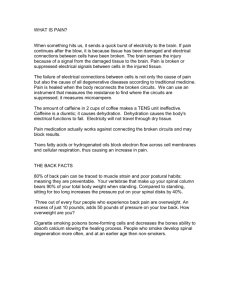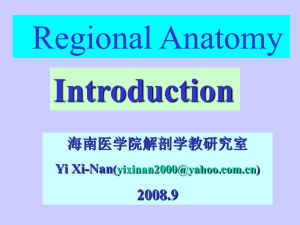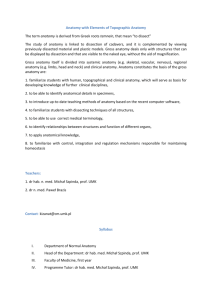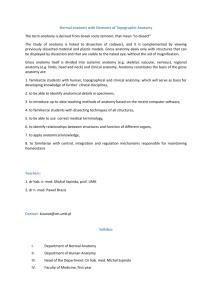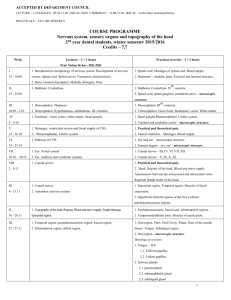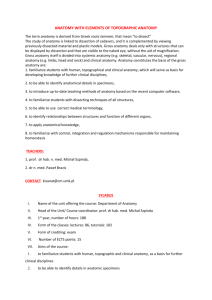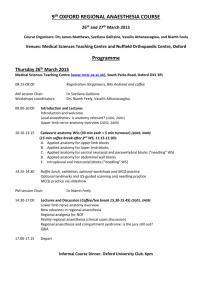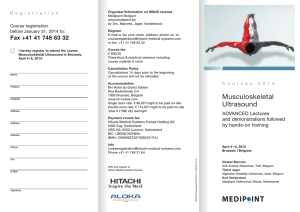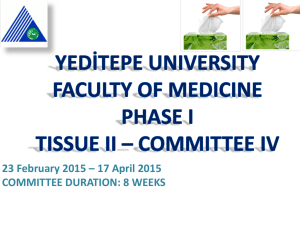NORMAL ANATOMY WITH ELEMENTS OF REGIONAL ANATOMY
advertisement
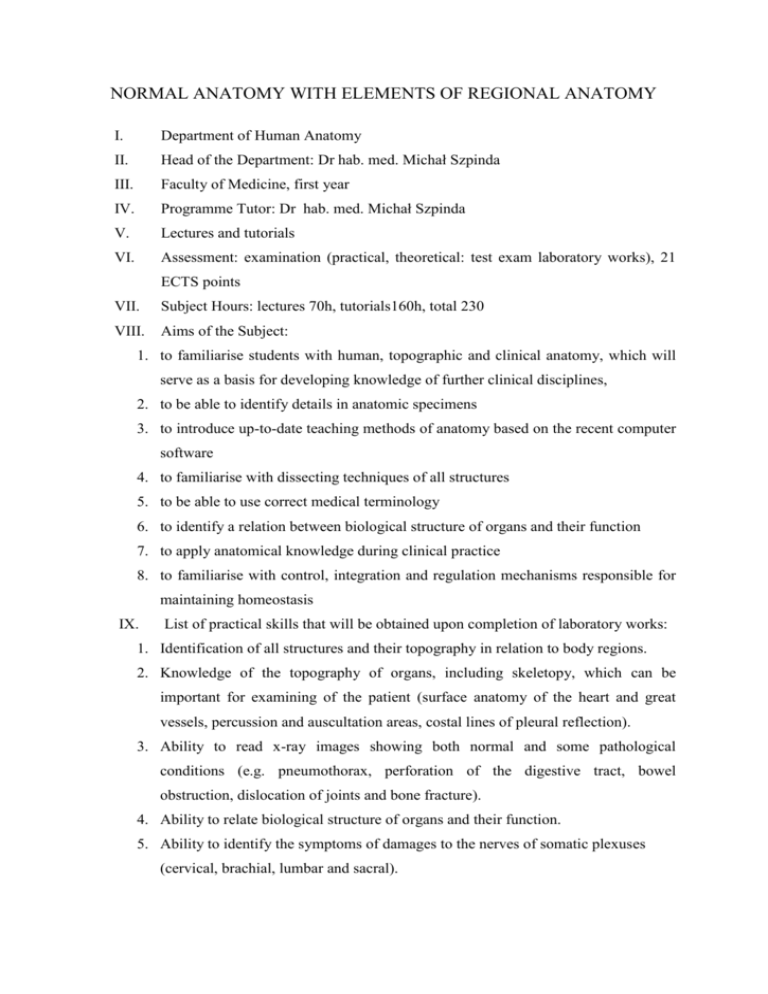
NORMAL ANATOMY WITH ELEMENTS OF REGIONAL ANATOMY I. Department of Human Anatomy II. Head of the Department: Dr hab. med. Michał Szpinda III. Faculty of Medicine, first year IV. Programme Tutor: Dr hab. med. Michał Szpinda V. Lectures and tutorials VI. Assessment: examination (practical, theoretical: test exam laboratory works), 21 ECTS points VII. Subject Hours: lectures 70h, tutorials160h, total 230 VIII. Aims of the Subject: 1. to familiarise students with human, topographic and clinical anatomy, which will serve as a basis for developing knowledge of further clinical disciplines, 2. to be able to identify details in anatomic specimens 3. to introduce up-to-date teaching methods of anatomy based on the recent computer software 4. to familiarise with dissecting techniques of all structures 5. to be able to use correct medical terminology 6. to identify a relation between biological structure of organs and their function 7. to apply anatomical knowledge during clinical practice 8. to familiarise with control, integration and regulation mechanisms responsible for maintaining homeostasis IX. List of practical skills that will be obtained upon completion of laboratory works: 1. Identification of all structures and their topography in relation to body regions. 2. Knowledge of the topography of organs, including skeletopy, which can be important for examining of the patient (surface anatomy of the heart and great vessels, percussion and auscultation areas, costal lines of pleural reflection). 3. Ability to read x-ray images showing both normal and some pathological conditions (e.g. pneumothorax, perforation of the digestive tract, bowel obstruction, dislocation of joints and bone fracture). 4. Ability to relate biological structure of organs and their function. 5. Ability to identify the symptoms of damages to the nerves of somatic plexuses (cervical, brachial, lumbar and sacral). 6. Ability to identify deficiency signs of damage to the motor and sensory pathways, occurring at different levels of central nervous system and within peripheral nervous system. 7. Knowledge of the most important anatomic anomalies (e.g. vascular variations) and developmental anomalies (e.g. visceral inversion, persisting urachus, Meckel’s diverticulum, transposition of the great arteries). X. Lecture Topics: Semester I 1. Junctions of Vertebral Column and Thorax 2. Junctions of Upper and Lower Limbs 3. Classification of Nervous System. The Spinal Nerves 4. Biomechanics of Movement in Skeletal Muscles 5. Brachial Plexus 6. Autonomic Nervous System 7. Systemic, Pulmonary and Fetal Circulation 8. Alimentary System and Peritoneum 9. Veins of the Abdomen and Pelvis. Portocaval and Cavocaval Anastomoses. 10. Autonomic Nervous System of Abdomen and Pelvis 11. Urinary and Reproductive Systems 12. Pelvic Canal 13. Lymphatic System 14. Lumbar and Sacral Plexuses 15. Topographical Anatomy of Lower Limb Semester II 1. Petrous Part of Temporal Bone 2. Topographical Anatomy of the Skull 3. Larynx 4. Overview of Cranial Nerves. Trigeminal Nerve 5. Cranial Nerves 6. Autonomic Nervous System of the Head and Neck 7. Carotid arteries 8. Internal Ear 9. General characteristics of the Brain 10. Motor Pathways 11. Sensory Pathways 12. Visual, auditory, olfactory and vestibulary pathways 13. Hypothalamus 14. Limbic System 15. Endocrine System XI. Tutorials Semester I 1. Anatomical axes and planes. General structure of bones. Classification of junctions and joints. Classification of skeleton. Regional characteristics of the vertebrae. General structure of vertebral column. Curvatures of the vertebral column. 2. Ribs and sternum. Skeleton of the thorax. Junctions of the thoracic wall and vertebral column. Movements of thorax and vertebral column. Imaging of thorax and vertebral column. 3. Bones, joints and ligaments of the upper limb. Imaging of upper limb. 4. Bones, joints and ligaments of the lower limb. Imaging of lower limb. 5. Osteology: Practise and test 1 6. Regions of upper limb. Surface anatomy of the upper limb. Muscles and fasciae of upper limb. Synovial sheaths of hand. 7.The spinal nerves. Brachial plexus. Lesions of nerves in the upper limb. 8.Arteries, veins and lymphatic vessels of upper limb. Places for measuring pulse in the upper limb. Fractures of upper limb’s bones causing injuries of nerves and blood vessels. Topographical anatomy of upper limb: axillary cavity, axillary fossa, deltopectoral triangle and groove, bicipital grooves, radial nerve canal, ulnar canal, cubital fossa, forearm grooves, carpeal canal, radial fovea. 9. Upper limb: Practise and test 2 10. Lines and regions of thorax and back. Muscles and fasciae of thorax and back. Diaphragm. The mammary gland. 11. Intercostal nerves. Short branches of braxial plexus. Dorsal branches of the spinal nerves. Phrenic nerve. Thoracic part of vagus nerve. Thoracic part of sympathetic trunk. Cardiac plexus. 12. Heart and pericardium. Surface anatomy of the heart and great vessels, percussion and auscultation areas, heart sounds. Ascending aorta, arch of aorta, thoracic aorta. Pulmonary trunk, pulmonary arteries. Pulmonary veins. Superior cava vein. 13. Trachea and principial bronchi. Bronchopulmonary segmentation (tree). Lungs. Pleural cavity. Mechanics of respiration. 14. Thymus. Esophagus. Thoracic duct and right lymphatic duct. Azygos veins system. Topographical anatomy and subdivisions of mediastinum. Topographical anatomy of the back: suboccipital triangle, intersplenial triangle, superior and inferior lumbar triangle, triangle of auscultation. 15. Thorax: Practise and test 3 16. Regions of abdomen. Muscles and fasciae of abdomen. Inguinal canal. Rectus sheath. Abdominal hernias. Lower intercostal nerves. Lumbar plexus. Peritoneum. Omental bursa, epiploic foramen, lesser and greater omentum. Peritoneal cavity and peritoneal reflections. 17. Abdominal part of esophagus, stomach, duodenum. Liver, gallbladder and biliary ducts. Pancreas. Spleen. Celiac trunk. 18. Small and large intestines. Superior and inferior mesenteric arteries. Portal vein. 19. Retroperitoneal space. Abdominal aorta. Inferior cava vein. Abdominal lymphatic system. Lumbar part of sympathetic trunk. Celiac and intermesenteric plexuses. Topographical anatomy of posterior abdominal wall. 20. Abdomen: Practise and test 4 21. Regions of perineum. Pelvis and urogenital diaphragm. Internal iliac artery. Inferior hypogastric plexus. Pudendal nerve. Lumbar splanchnic nerves. Neurovascular connective tissue lamina. Pelvic canal. Fibrous spaces of pelvis. Ischiorectal fossa. Pubic recess. Pudendal canal. Superficial and deep perineal space. Greater and lesser sciatic foramina. 22. Urinary system - organs, vessels and nerves 23. Male genital system - division, organs, vessels and nerves 24. Female genital system - division, organs, vessels and nerves 25. Pelvis: Practise and test 5 26. Regions of lower limb. Muscles and fasciae of lower limb. Synovial sheaths of lower limb. 27. Sacral and lumbar plexuses. Lesions of nerves in the lower limb. 28. Arteries, veins and lymphatic vessels of lower limb. The places for pulse measuring in the lower limb.Topographical anatomy of lower limb: muscular and vascular lacuna, femoral canal, adductor canal, greater and lesser triangles, iliopubic fossa, popliteal fossa, medial and lateral ankle canals. 29. Lower limb: Practise and test 6 30. Revision of semester I Semester II 1. General structure (overview) of cranium. Parietal bone, temporal bone, occipital bone. Canals of temporal bone. Tympanic cavity. 2. Sphenoid bone, frontal bone, ethmoid bone, palatine bone, maxillae, inferior nasal concha, zygomatic bone, lacrimal bone, vomer, nasal bone, mandible, hyoid bone. Paranasal sinuses. Fonticuli (fontanelles). 3. Osteal exits of cranial nerves. Temporomandibular joint. Cranial synchondroses and syndesmoses. Anterior, middle and posterior cranial fossae. Orbit. Pterygopalatine fossa. Temporal and infatemporal fossae. Nasal cavity. Retromandibular fossa. Passage of cranial nerves through openings in the cranial base. 4. Skull: Practise and test 1 5. Regions of neck and head. Muscles and fasciae of neck and head. Triangles of neck. Fascial compartments of the neck. 6. External nose and nasal cavity. Paranasales sinuses. Oral cavity. Tongue. Deciduous and permanent teeth, hard and soft palate. Pharynx. Salivary glands: submandibular, sublingual and parotid. 7. Larynx. Thyroid and parathyroid glands. Cervical part of esophagus and trachea. 8. Common, internal and external carotid arteries. Subclavian artery. 9. Dural infoldings and dural venous sinuses. Intracranial haemorrhages. Veins of the head. Internal, external and anterior jugular veins. Lymphatic nodes and vessels of neck and head. 10. Cervical plexus. Olfactory, optic, oculomotor, trigeminal and abducent nerves. 11. Facial, intermediate, glossopharyngeal, vagus, accessory and hypoglossal nerves. Autonomic nervous system of neck and head. Cranial parasympathetic ganglia. Parasympathetic innervation of lacrimal, parotid, submandibular and sublingual glands. 12. Topographical anatomy of the head: orbit, pterygopalatine fossa, temporal fossa, infatemporal fossa, nasal cavity, oral cavity, retromandibular fossa, parapharyngeal space, retropharyngeal space, buccal space. Limitations and contents. 13. Neck and Head: Practise and test 2 14. Visual apparatus. Eyeball, accessory visual apparatus. Optic nerve. Nerves of extraocular muscles (III, IV, VI). Pupillary light reflex and accommodation reaction. 15. Auditory and vestibular apparatuses. External, middle and internal ear. Vestibulocochlear nerve. Sound pathway. 16. Sensory Organs: Practise and test 3 17. Ontogenetic, topographical and anatomical classification of the brain. Gross structure of the brain. Cerebral cortex: main sulci and fissures, lobes and gyri. The main cortical areas. Telencephalic nuclei. White matter of hemispheres. Small brain (rhinencephalon). Limbic system components. Lateral ventricle. 18. Diencephalon. Third ventricle. Thalamus and hypothalamus. 19. Mesencephalon. Cerebral aqueduct. Metencephalon. 20. Myelencephalon. Spinal cord. Cranial nerve nuclei in the brain stem. Fourth ventricle. Reticular formation of the brain stem. Cranial meninges. Cerebellum and spinal cord. Subarachnoid space. Circulation of cerebrospinal fluid. Arteries of the brain, circulus arteriosus of Willis. Lumbar puncture. 21. Neuroscience - brain: Practise and test 4 22. Nerve fascicles of the cerebrum (association, projection and commissural fibres). Extrapyramidal system. Pyramidal (corticospinal) tracts. Dysfunction of efferent pathways. Spinocerebellar tracts. Vestibular tract. 23. Pathways of thalamus and hypothalamus. Integration of autonomic functions. Afferent pathways of internal organs. Ascending tracts (dorsal funiculus, spinothalamic tracts). Dysfunction of efferent pathways. The role of limbic system and its relation with afferent and efferent fibres. 24. Reticular system. Tegmental central tract. Medial longitudinal fasciculus. Tracts of extrapyramidal system. Visual, auditory, olfactory and gustatory pathways. Hemisection and transection of the spinal cord. 25. Neuroscience - nervous pathways: Practise and test 5 26. Topographical and clinical anatomy of limbs. 27. Topographical and clinical anatomy of trunk. 28. Topographical and clinical anatomy of neck and head. 29. Topographical anatomy: Practise and test 6 30. Revision of semester II. XI. Bibliography - basic: 1) Moore Keith L. and Dalley Arthur F. Clinically Oriented Anatomy. Lippincott Williams & Wilkins, 5th ed., 2009. 2) Drake R. Gray’s Anatomy for Students. Ed. Churchill Livingstone, 2nd ed., 2009. 3) Tank P. W. Grant’s Dissector. Lippincott Williams & Wilkins, 13th ed., 2005. 4) Agur Anne M.R., Dalley Arthur F. Grant’s Atlas of Anatomy. Lippincott Williams & Wilkins, 11th ed., 2005. 5) Weir J., Abrahams P.H. Imaging Atlas of Human Anatomy, Mosby, 3rd ed., 2003. 6) Chung Kuang W. Gross Anatomy - Board Review Series, Lippincott Williams & Wilkins, 5th ed., 2005. 7) Netter Frank H. Atlas of Human Anatomy. Urban & Partner, 3rd ed., 2006. NEUROSCIENCE 1) Young Paul A. and Young Paul H. Basic Clinical Neuroanatomy. Lippincott Williams& Wilkins, 1997. 2) Brodal Per The Central Nervous System. Oxford Univ. Press, 2004. 3) Waxman S.G. Clinical Neuroanatomy. 25th Edition, McGraw-Hill, 2003. 4) Haines Duane E. Fundamental Neuroscience for Basic and Clinical Applications. 3rd ed., Elsevier, 2006. 5) Haines Duane E. Neuroanatomy: An Atlas of Structures, Sections and Systems. 7th ed., Lippincott Williams &Wilkins, 2007. 6) Fix, J.D. Neuroanatomy - Board Review Series, 3rd ed., Culinary and Hospitality Industry Publications Services, 2006. XII. Bibliography - additional Journals: 1) „Folia Morphologica” 2) „Annals of Anatomy”.
